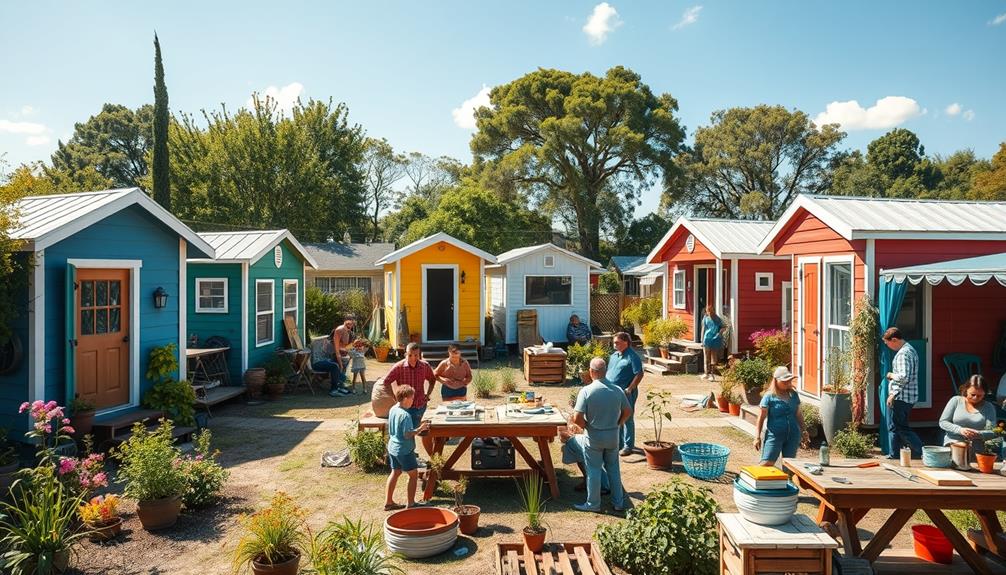Reviving 1950s architecture ignites a DIY revolution that's all about clean lines and open spaces. You can embrace open floor plans to create flow and connectivity in your home. Large windows and sliding glass doors will invite natural light, enhancing indoor-outdoor living. Use earthy tones like burnt orange and olive green to capture that mid-century vibe. Don't forget to source authentic decor and iconic furniture to add character. As you explore techniques and resources, you'll find innovative ways to honor this timeless style while making it your own. Those ideas wait for you just around the corner. To fully embrace the 1950s architecture revival, consider incorporating minimalist home design elements such as sleek countertops and minimalist furniture. Utilize clean, simple lines and decluttered spaces to achieve a modern interpretation of the mid-century style. By merging the principles of minimalism with the iconic features of 1950s architecture, you can create a timeless and effortlessly chic living environment.
Key Takeaways
- Embrace open floor plans to enhance spaciousness and create a sense of connectivity in your 1950s architectural revival.
- Incorporate large windows and sliding glass doors to maximize natural light and promote indoor-outdoor living.
- Use earthy tones like burnt orange and olive green to capture the warmth and authenticity of mid-century design.
- Select mid-century furniture with clean lines and tapered legs to maintain the aesthetic integrity of the era.
- Source authentic decor from vintage stores and online marketplaces to enrich your 1950s architectural revival with genuine pieces.
Key Features of 1950s Architecture

When you think of 1950s architecture, you can't help but picture clean lines and minimal ornamentation that define this iconic style.
This era brought a groundbreaking fusion of functionality and artistry, creating spaces that felt both modern and inviting. The focus on innovative design and functionality can be seen in the open floor plans that enhance spaciousness, promoting connectivity between rooms.
Large windows flood interiors with natural light, while sliding glass doors blur the line between indoor and outdoor living, exemplifying the commitment to sustainability that was beginning to emerge.
Earthy tones like burnt orange and olive green create a warm ambiance, and mid-century modern elements, such as flat roofs and colorful kitchens, set lasting trends.
A-Frame houses stand out with their distinctive triangular shapes, featuring exposed wood beams and stone fireplaces, showcasing the elegance of simplicity that defines 1950s design.
Essential DIY Renovation Tips

Revamping a space with 1950s charm can be an exciting project that breathes new life into your home. Start by embracing open floor plans to enhance flow and connectivity, as this aligns with the era's design principles.
Incorporate large windows or glass walls to invite in natural light, creating an airy atmosphere, which is essential for capturing the essence of mid-century modern aesthetics. Stick to earthy tones like burnt orange and olive green for an authentic feel.
When selecting furniture, choose pieces with clean lines and tapered legs to reflect mid-century style, drawing inspiration from mood boards essential for visualizing design concepts. Flat or slightly angled roofs add authenticity, while sliding glass doors promote seamless indoor-outdoor living.
Don't forget to source authentic decor to maintain the design's integrity. With these essential tips, you'll be well on your way to capturing the essence of 1950s architecture.
Adding Retro Flair to Spaces

To infuse your spaces with retro flair, start by incorporating iconic mid-century furniture pieces that define the era's style.
Think clean lines and vibrant colors that bring warmth to your home, much like the modern farmhouse decor trends that emphasize natural materials and neutral palettes.
Here are a few essentials to take into account:
- Saarinen's Tulip table: A statement piece that combines elegance and simplicity.
- Wegner's Wishbone chair: Perfect for adding a touch of craftsmanship and comfort.
- Nelson Saucer Crisscross pendant: An eye-catching lighting fixture that enhances the retro vibe.
Additionally, embrace earthy tones and geometric patterns to create a cohesive look.
Mix in textures like wood and metal to add depth.
Finding Authentic Home Decor

Hunting for authentic 1950s home decor can be an exciting journey filled with unique finds that tell a story.
Start by exploring vintage stores for curated selections that capture the era's essence. Retro furniture shops often specialize in mid-century styles, offering pieces that scream authenticity.
Don't overlook estate sales—they're treasure troves for hidden gems waiting to be discovered. Online marketplaces like Etsy, eBay, and Chairish also provide access to original items, making it easier to find what you need.
Finally, check out auction houses and antique fairs for unique decor that can elevate your space.
With a little patience and creativity, you'll create a home that reflects the charm and sophistication of the 1950s.
Community Resources for Tiny Home Owners

If you're diving into the world of tiny home living, tapping into community resources can make all the difference.
Here are some ways to connect and enhance your experience:
- Join local Facebook groups like Arizona Tiny House Community for support and advice.
- Attend tiny house meetups and events to network with like-minded enthusiasts.
- Explore workshops focused on sustainable tiny living to expand your knowledge.
These resources not only provide valuable information but also foster a sense of belonging.
Don't forget to stay informed about zoning laws and potential tax exemptions for tiny homes.
Engaging with your community can lead to new friendships and opportunities, making your tiny home journey that much more enjoyable.
Embracing Sustainable Design Elements

As you connect with your tiny home community, consider how sustainable design elements can enhance your living space.
Embracing passive solar gain allows you to harness natural sunlight, reducing energy costs and minimizing your carbon footprint. Use large windows and sliding glass doors to invite light and create an indoor-outdoor flow, typical of 1950s architecture.
Opt for eco-friendly materials like reclaimed wood and low-VOC paints to maintain a healthy environment. Incorporate energy-efficient appliances and fixtures to further your commitment to sustainability.
Choosing earthy tones not only reflects mid-century style but also connects you with nature.
Navigating Zoning Laws and Regulations

Understanding zoning laws is essential for anyone looking to build or live in a tiny home. These regulations can shape your entire project, so it's vital to get familiar with them.
Here are a few key points to take into account:
- Types of zones: Know whether your land is designated for single-family homes, multi-family units, or accessory dwelling units (ADUs).
- Tiny home classifications: Tiny homes on wheels may fall under RV regulations, affecting where you can park them.
- Property tax implications: Be aware of potential exemptions based on size and sustainable features.
Navigating these laws can be intimidating, but doing your homework guarantees you're compliant and can fully enjoy your retro-inspired living space without unexpected hurdles.
Frequently Asked Questions
How Can I Blend Modern Design With 1950S Architecture?
To blend modern design with 1950s architecture, incorporate clean lines and open spaces. Use large windows for natural light, earthy tones for warmth, and mix vintage furniture with contemporary pieces for a cohesive, stylish look.
What Are Common Challenges in Renovating 1950S Homes?
Renovating 1950s homes often presents challenges like outdated materials, structural issues, and zoning regulations. You'll need to balance preserving vintage charm while updating for modern needs, ensuring your design is both functional and authentic.
Are There Specific Materials Recommended for 1950s-Style Renovations?
For your 1950s-style renovations, consider using wood, glass, and brick for authenticity. Incorporate bold colors and retro materials like laminate and chrome to capture that mid-century vibe while ensuring your space feels fresh and inviting.
How Do I Maintain the Structural Integrity of Vintage Homes?
To maintain the structural integrity of vintage homes, you should regularly inspect the foundation, address any water damage promptly, reinforce weak areas, and use appropriate materials that match the original construction for repairs and renovations.
What Are the Costs Associated With Restoring 1950S Architecture?
Restoring 1950s architecture can vary widely in costs, typically ranging from $10,000 to $100,000. You'll need to take into account materials, labor, and potential permits, so budgeting effectively will guarantee your project's success and integrity.
Conclusion
As you step back into your revitalized space, breathe in the warm hues of burnt orange and olive green, and feel the gentle breeze through your sliding glass doors. You've woven together the charm of the 1950s with your personal touch, creating a harmonious retreat that celebrates both style and function. Embrace the simplicity and elegance of this era, and let your home tell a story of nostalgia and modern living, inviting friends and family into your airy oasis.










